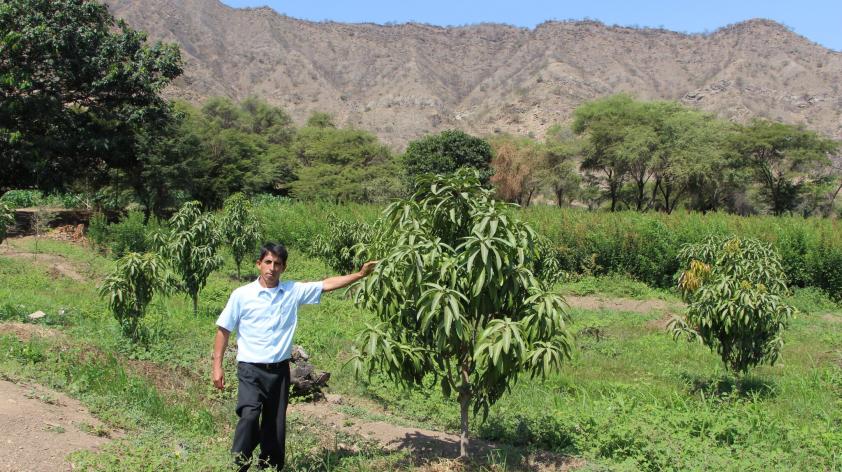
Learning from Locals
“I don’t want to freak you out, but Robyn in Peru said there’s a mild case of dengue going around.” And “Do you think you could fit 24 pounds of peanut butter in your bag?” These were the last two texts I received from my mentor, Samantha Young, as I was preparing to depart to the Rio La Leche watershed in Northwestern Peru. I was going to assist Samantha in conducting an impact assessment of a five-year conservation education initiative, in conjunction with the Spectacled Bear Conservation Society (SBC), and as part of my summer fellowship in the Conservation Education Division. We planned to assess whether there has been a shift in attitudes, behavior, and knowledge about conservation in the area. I was initially informed that there was a “slight chance” I would have the opportunity to travel, but I never thought that it would actually happen! I was ecstatic.
I conducted a great deal of research on the project prior to departure, and learned about the different programs that have been implemented in the region, as well as the ecosystem and cultures of the dry forest of the Rio La Leche watershed. I read about spectacled bears, past blogs of colleagues who had worked with SBC, written and re-written the surveys that were to be administered, and got my grandma to talk to me exclusively in Spanish in preparation. However, this wasn’t going to be my first time in South America working with community-based conservation initiatives and, since my visit to South America four years ago, I had been itching to go back. I thought I was ready to depart and get down to business. But, those texts I received less than 48 hours before I was set to leave, caused me to question my readiness and whether my research had fully prepared me.
To some degree I was right; regardless of how much research I did in advance, I wasn’t going to be fully prepared until I got there and met with members of the community and SBC field team. I needed to see, with my own eyes, what was happening to truly understand why conservation efforts in this region are so important. While there, I learned, and was able to experience, the uniqueness of the dry forest—a transitional zone between tropical forest and desert—a biodiversity hotspot home to many endemic species (found nowhere else in the planet). Speaking with SBC staff I could see how passionate they were, and got a better understanding of why it was critical to learn about Andean bears in the dry forest. But as I learned more and more, a question kept reappearing in the back of my head: “Does the community understand how important their own backyards are to critical conservation efforts?” I was excited to start doing interviews with community members to try and answer this question.
While conducting interviews, I found that many individuals who live in these rural communities have actually seen a spectacled bear with their own eyes while working in the field—some of the same bears that SBC staff has dedicated their lives to protecting. For me, it became very evident at that point how important the human dimension of conservation is. The key threats that spectacled bears face are human-generated. Hence, it is impossible to preserve the species without engaging the people who share the bear’s habitat. For example, what good is it that researchers have identified the Sapote tree as a staple food source for bear populations in the dry forest if local community members continue to uproot the tree for wood and land use?
I also realized that what is “local” doesn’t always translate. I have come to understand the importance of looking at conservation from a cultural perspective; there is a strong need to understand the values of a culture to understand the role conservation can play. Perhaps this is one of the reasons why we encountered numerous problems in trying to initiate the survey. I was under the impression that once I translated the instrument to Spanish it would be good to go. We ended up drafting about 10 different iterations of the survey, and we could have kept going. We found that certain words didn’t have the same cultural significance, and individuals were interpreting the questions in ways that we had not initially intended.
During this trip to Peru, I had the opportunity to learn from children and adults regarding their perspectives on the nearby wildlife, items of importance in their daily lives, how environmental education has worked in a school setting, and their present understanding of protected areas. The level of awareness and understanding about the importance of protecting our environment was impressive to me. Almost every school we went to had posters displayed, and projects dedicated to caring for the natural environment. This was a huge contrast from my first experience in South America, and I can’t help but think that these differences can be attributed to the education programs that have been implemented in this region.
We conducted 466 interviews and surveys with community members. Fortunately, we left the 24 pounds of peanut butter for the SBC field staff which freed up some space in our bags to take the of surveys back to the U.S. Now all that is left for me to do is sort through thousands of pieces of paper to input and analyze all the data we collected to even better understand current attitudes and opinions about spectacled bear conservation, as well as conservation in general. Traveling back home a bit lighter and dengue-free, I couldn’t wait to get started.













